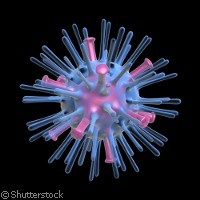Feb 6 2009
EU-funded scientists in France have defined an important drug target in the influenza virus. The study, published in the journal Nature, shows a high-resolution image of a crucial protein that allows the virus to 'hijack' human cells and multiply. The study is part of the FLUPOL ('Host-specific variants of the influenza virus replication machinery') project, funded with EUR 1.97 Million under the Policy support budget line of the Sixth Framework Programme (FP6).

Seasonal influenza epidemics kill hundreds of thousands of people every year. According to FLUPOL, the deadly H5N1 avian influenza viruses have the potential to cause a devastating pandemic if they become transmissible between humans. The goal of the three-year research project is to provide new knowledge that will enable scientists to better monitor the influenza virus and find ways to combat the emergence of deadly strains. To do this, it is crucial that the mechanisms whereby the virus can adapt itself from bird hosts to humans be fully understood.
The influenza virus multiplies rapidly within its host's cells, aided by a viral enzyme called polymerase. The polymerase copies the virus's genetic material and manipulates the host cell to provide a friendly environment for the virus to multiply. The polymerase takes a piece of the host's RNA (genetic material) and adds it to its own. The result: the host's cell starts to produce viral proteins.
The part of the RNA that gets 'hijacked' is called the cap, a short bit of the molecule that is found at the beginning of messenger RNA that directs the manufacture of proteins. The viral polymerase swipes the cap and sticks it onto its own RNA. The process, referred to as 'cap snatching', has until now been unclear.
The viral polymerase is known to be composed of three subunits (PA, PB1 and PB2); the question of which subunit is the cap-snatcher has been a matter of some controversy. While previous studies demonstrated that PB2 plays a role in cap binding; PB1 was believed to be the cap-snatching culprit.
Now, the team led by Dr Stephen Cusak of the European Molecular Biology Laboratory (EMBL) and Dr Rob Ruigrok of the National Centre for Scientific Research (CNRS) discovered that a different part of the polymerase, PA, is actually responsible for slicing the cap off the host's mRNA.
The investigators created crystal structures of the polymerase subunits, and examined them under X-ray beams at the European Synchrotron Radiation Facility (ESRF) in Grenoble, France. The resulting high-resolution image clearly showed the individual amino acids that form the site where the cap is cleaved from the mRNA. The scientists revealed that the PA subunit plays a unique role in cleaving the RNA.
'Our results came as a big surprise, because everybody thought that the cleaving activity resides in a different part of the polymerase,' said Dr Ruigrok. Dr Cusack added: 'These new insights make PA a promising antiviral drug target. Inhibiting the cleaving of the cap is an efficient way to stop infection because the virus can no longer multiply. Now we know where to focus drug-design efforts.'
Their findings are supported by a second study, published in the same issue of Nature, by researchers in China and the UK which shows PA to be an important target for the design of new anti-influenza therapies.
Source: Cordis